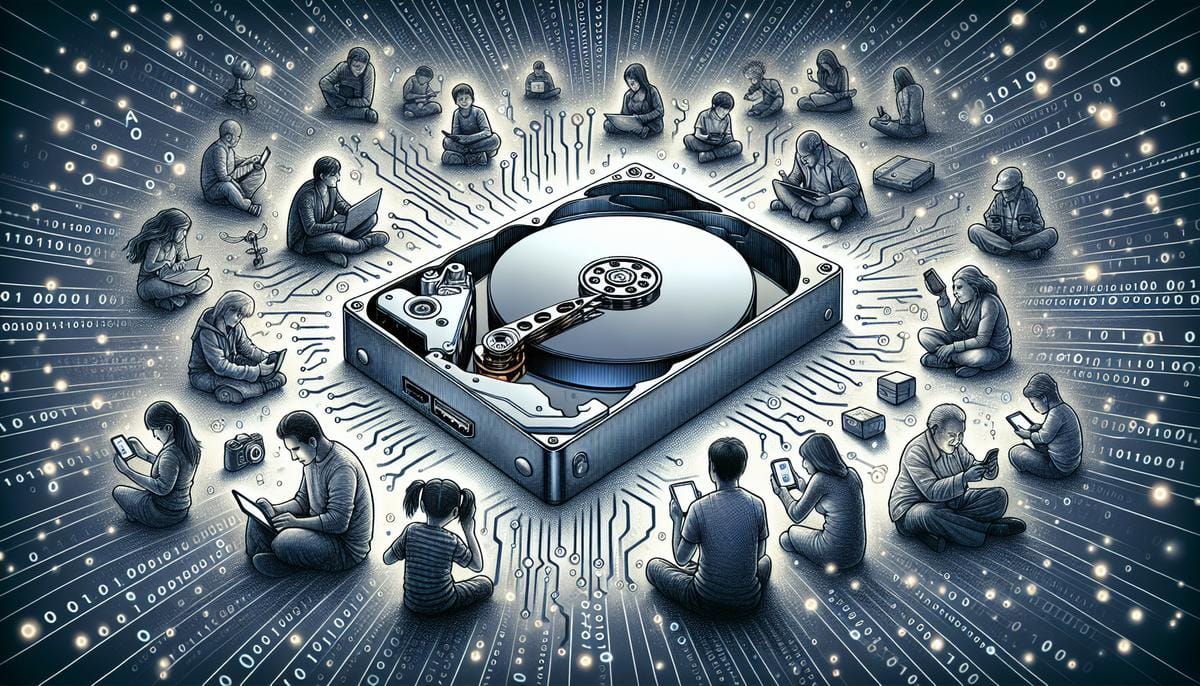The Ultimate Guide to Backing Up Your Digital Life

Welcome to the digital age, where our lives are filled with cherished memories in the form of photos and important documents that exist in the virtual realm. It's fantastic having all this information at our fingertips, but let's face it, technology isn't foolproof. Hard drives fail. Phones get lost or stolen. Natural disasters happen. And sometimes, we accidentally delete files that we didn't mean to wave goodbye to. That's why backing up your files is as essential as locking your doors at night - you're protecting precious assets. So buckle up as we take you on a journey through the world of backups - and no need to bring any technical jargon dictionaries, we're keeping it simple and fun!
Why Backup is Essential
Think of all the precious moments you've captured on your camera - the first steps of a child, the sun setting on a perfect vacation, the family reunions. Now think of all your important documents - tax returns, legal documents, work reports. With all that important and sentimental data, losing any of it would be like losing a piece of your history. Backing up your data is like creating a digital safety net. Whether it's a hardware malfunction, a virus attack, or a simple human error, backups ensure that you can retrieve your data and continue life uninterrupted. So, let's make sure your digital life is bulletproof !
The Best Backup Methods
Not all backup methods are created equal. There are several options out there, but we'll focus on the three that stand out in terms of reliability, ease of use, and convenience: external hard drives, cloud storage services, and network-attached storage (NAS).External hard drives are like the trusty old safe where you keep physical copies of your important documents. They're relatively inexpensive, offer lots of storage space, and are pretty straightforward to use—just plug them into your computer, drag and drop your files, and voila!Cloud storage services, on the other hand, are like renting a safety deposit box in a top-notch bank. Providers like Google Drive, Dropbox, and iCloud offer you storage space on their servers which you can access from anywhere at any time as long as you have an internet connection. Most services offer a free tier with limited storage space, and you can pay a subscription fee for more space.Lastly, NAS is like having your very own mini data center at home. It's a bit more complex and pricier than the other two options but offers benefits like massive storage capacity, data redundancy, and the ability to access your files from multiple devices on your home network.
In the next sections, we'll dive into each backup method further, and by the end of this guide, you'll be a veritable backup wizard—or at least a very well-prepared muggle.
Setting Up Your Backup System
Once you've chosen your backup method—or maybe a combination of a few—it's time to set up your system. If you're going the external hard drive route, the setup is generally a plug-and-play affair. However, do remember to format your new drive according to your computer's operating system to ensure compatibility. For Windows, that'll typically be NTFS, and for Macs, it's usually either HFS+ or the newer APFS. And hey, many external hard drives now come with handy backup software that can automate the process for you, so keep an eye out for that.Cloud storage setup is also quite user-friendly. After creating an account with your chosen provider, you can download their app or use your web browser to upload your files. Most cloud services integrate nicely with your desktop, creating a folder that automatically syncs whatever you put in it. If you decide to go all out with a NAS, the setup involves a few more steps and a bit of networking know-how. After installing the hard drives into the NAS system and connecting it to your network, you'll set it up via its interface, accessed through a web browser on your computer. This will include creating user accounts, setting up file-sharing permissions, and possibly configuring redundancy (like RAID) to ensure your data is double-protected.Remember to check for software updates for whatever method you choose regularly, as these can contain important security patches and new features.
Automating Your Backup
The best kind of backup is the one you don't have to think about, and that's where automation comes in. Setting up automatic backups not only saves you time and effort but also ensures that your data is consistently protected without you having to lift a finger. For external drives, you can use built-in tools like Windows Backup or Time Machine on macOS, which allow you to set a schedule for your backups. You can select which files and folders to include in your backup and then let the software take care of the rest. Cloud storage services usually do the heavy lifting for you. With their desktop apps installed, files in the sync folder are automatically backed up to the cloud without any action on your part. And let's not forget mobile apps which can automatically backup photos and videos from your phone to the cloud, making sure each snapshot of life is preserved without you even thinking about it.NAS devices also offer several options for automating your backups, including scheduled backups and real-time file syncing. Many NAS systems come with proprietary software that can help set up these automated tasks, or you can use third-party applications depending on your needs and the NAS feature set.Automating your backups serves two key purposes: it removes the risk of human error (forgetting to backup) and it ensures that the most current version of your files is saved, reducing the chances of losing important updates or changes made between manual backups.
In the next sections, we'll go over how to ensure your backups are solid with regular testing and what to do in case you need to recover those precious files.
Testing Your Backup
So, you've set up your backup system and everything is running smoothly—or is it? The only way to truly ensure that your backup plan is sound is to regularly test it. Testing your backup system ensures that your files can be recovered in the event of a disaster. It's like a fire drill for your digital documents—you hope you never have to deal with the real thing, but it's crucial to be prepared if you do.Start by restoring a few key files from your backup to a safe location on your main device to check their integrity. You can pick out some random documents, or those that you updated recently. If they open and function as expected, then your backup is good to go. In the case of cloud services or NAS, try accessing the files from a different device or even remotely from a mobile device, to ensure that accessibility is seamless.It's also important to check that your backup system is capturing every important file. Don't assume that just because you set it up once, it's always capturing the right data. As you create new folders or change the structure of your files, you might need to adjust your backup settings to include those new directories. If you're using automatic backup software, periodically check in to make sure the software is successfully running the backup operations as scheduled. If there are any errors or missed backups, investigate the cause and correct it so that your system continues to function correctly.Remember: the goal of a backup is to recover data, and if you can't recover it during a test, you won't be able to recover it during a real-life data loss incident. Regularly testing your backups gives you peace of mind and ensures your digital safety net is always ready to catch you.
Recovering Your Files
In the unfortunate event that you do need to retrieve files from your backup, it's essential to know the steps. Whether you've faced a catastrophic computer crash or you've fallen victim to a viral attack—knowing the recovery process can get you back on track with minimal downtime.If you're using an external hard drive, recovery can be as simple as plugging the drive into another computer and copying the files over. Cloud storage services typically allow you to both access and restore files via their web interface or mobile app. Some services even allow you to restore previous versions of files if you've accidentally overwritten something important.With a NAS, recovery may involve logging into the device's administrative interface and selecting the files or folders you wish to restore. If you've set up a more complex RAID configuration, you may need to follow additional steps outlined in your NAS's user manual to ensure proper restoration.Regardless of your backup method, the key to smooth recovery is staying organized. Know where your backups are, what they contain, and how to access them. And in the case of cloud services and NAS devices, always secure your data with strong passwords and multi-factor authentication to prevent unauthorized access.In a recovery scenario, stay calm and methodically follow the steps to get your data back. And once you've successfully recovered your files, it might be a good time to review your backup strategies to see if there are any improvements or changes to be made based on the experience.
Conclusion: Backup Bliss
Embarking on the journey of backing up your photos and documents can seem daunting, but as you've seen, with the right setup and know-how, it's a breeze. You've now got the blueprint to building an impenetrable digital fortress around your most precious files. Regular backups—check! Automating—check! Testing and recovery plans—double-check! Facing a tech apocalypse without a backup plan is like going into a storm without an umbrella—unnecessarily risky. So arm yourself with the tools and tricks we've shared, and you'll be dancing in the rain, your digital life secure and dry.Remember, the time you invest now in setting up a backup system will pay off massively should disaster strike. Not only does peace of mind come from knowing your files are safe, but the convenience of accessing your data across multiple devices cannot be understated. So go ahead, pat yourself on the back, for you've not only protected your files - you've mastered the art of the backup! In the end, it's all about being proactive rather than reactive. So embrace your newfound confidence in your backup solutions, and may your digital memories and documents live on forever, safe from the unpredictabilities of the tech world.


